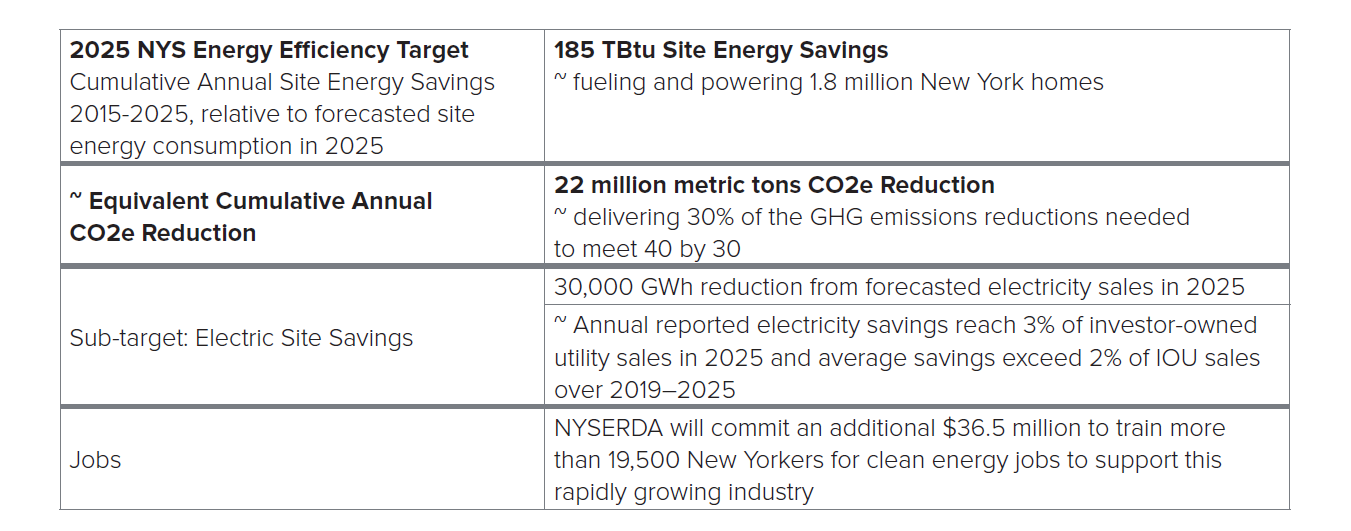by Steve Cowell
New York is stepping up as a national leader on energy and carbon reduction. And details matter. How will New York achieve its goals? How are stakeholders and advocates helping to provide direction?
In 2018 Governor Cuomo announced an ambitious energy efficiency initiative, eventually named New Efficiency: New York (NE:NY), which would utilize energy efficiency to meet roughly one-third of the state’s decarbonization goals. Under NE:NY the state’s utilities have greater responsibilities to implement energy efficiency programs in their territories to achieve the energy savings goals. On July 18, 2019, the Climate Leadership and Community Protection Act (CLCPA) was signed into law by Governor Cuomo. The law commits NY to net-zero emissions for the whole economy, and adds further pressure for the utilities and regulators to implement cost-effective efficiency programs that can help provide the necessary emission reductions.

Figure 1 – Goals of New Efficiency: New York
Advocating for Smart Implementation
In Spring 2019, as required by the NY Public Service Commission (PSC) in a December 2018 Order, the electric and gas utilities jointly filed their proposed savings targets and budgets. Stakeholders and advocates then submitted comments. Areas of strong agreement from stakeholders surfaced. Suggestions by commenters included:
- A recommendation that the PSC determine that the required savings goals should be the floor, not the ceiling. In addition, considering the ambitious requirements of the CLCPA, the utilities should be allowed to pursue all cost-effective energy efficiency measures for New York to help achieve net-zero emissions economy-wide.
- The need for revision of the state’s cost effectiveness testing and savings accounting methodology to reflect new policy objectives, including fuel switching, non-energy impacts and the savings interactions among different efficiency measures.
- Increased detail must be provided, to help stakeholders understand the program-level specifics for each utility’s filing. This will enable stakeholders and advocates to assist the utilities and involved agencies to achieve the state’s ambitious goals.
- A request that building shell improvements be emphasized and incentivized for customers accessing heat pump incentives. Requiring shell improvements will reduce the heating load of a building and reduce the cost of operating a heat pump, in addition to improving the overall system performance and allowing for heat pump incentive funds to support more systems.
Moving Forward
Last year, I applauded the Governor’s new efficiency goals as a step toward returning New York to the top three states listed in ACEEE’s annual scorecard. The utilities’ filing and stakeholder comments are encouraging initial steps toward returning the state to its status as a national leader in deploying efficiency as a resource, to achieve emission reduction while boosting the economy and creating thousands of additional jobs for New Yorkers. Achieving the state’s goals will not be easy. It is imperative that the PSC act decisively to encourage state agencies, utilities, and stakeholders to coordinate effectively through establishing a regular forum for reporting progress and engaging in dialogue with the energy efficiency community.
Let’s keep the pressure on. Contact policy@e4thefuture.org for more information or if you would like to collaborate.
–Steve Cowell is President of E4TheFuture
